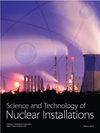评估1级多机组PSA内常见原因故障对现场风险的影响
IF 0.9
4区 工程技术
Q3 NUCLEAR SCIENCE & TECHNOLOGY
引用次数: 0
摘要
当启动事件干扰核电站的正常运行时,由于存在共同原因,共因故障可能导致核电站中许多组件同时不可用或故障。在多机组概率安全评估(MUPSA)中,共因失效(机组内和机组间)的存在可以被视为一个关键的依赖因素,它可以影响事故场景和堆芯损坏频率(CDF),因为共因失效可能会影响缓解系统的可用性和正确运行。由于此类故障可能会严重破坏核电站系统冗余概念的好处,因此有必要确定导致多机组场地堆芯损坏的CCF,并分析其总体定量大小和定性比例。在本研究中,使用AIMS-PSA软件对双机组通用压水堆(PWR)核电站进行了建模。对于厂外电源损失(LOOP)和电站停电(SBO)事件,计算了现场CDF,并针对故障树中建模的共因失效基本事件检查了通过该量化产生的割集。研究了CCFs对场地核心损伤频率的定量和定性贡献。建模故障树中的CCF对组合LOOP和SBO事件的现场CDF的贡献率为4.58%。在导致堆芯损坏的LOOP事件中,CCF对现场CDF的贡献率为4.58%,而在导致堆心损坏的SBO事件中CCF对场地CDF的影响率为17.19%。在建模过程中考虑共因失效事件的情况下,在联合LOOP和SBO事件中,共因失效估计的现场CDF增加了7.53%。在导致堆芯损坏的LOOP事件中,建模中包含共因失效事件使现场CDF增加了7.42%。与没有共因失效的建模相比,导致堆芯损伤的SBO事件中现场CDF仅增加了15.66%。结果表明,共因故障对站点CDF的贡献是多么重要。当考虑到共同原因故障时,现场CDF的增加会影响现场核电站的安全。通过导致机组堆芯损坏的最小割集,明确检查了各种共因失效基本事件组成及其百分比贡献。总之,这项研究的发现可以帮助我们更好地了解CCFs如何增加多单位部位的风险,也可以作为未来研究MUPSA中CCF效应定性和定量分类的起点。本文章由计算机程序翻译,如有差异,请以英文原文为准。
Assessing the Impact of Common Cause Failures on Site Risk within Level 1 Multi-Unit PSA
Common cause failures (CCFs) may lead to the simultaneous unavailability or failure of numerous components in the nuclear power plant because of the existence of a shared cause when an initiating event disrupts the normal functioning of nuclear power plants. The presence of common cause failures (intra-unit and inter-unit) can be recognized in a multi-unit probabilistic safety assessment (MUPSA) as a crucial dependency factor that can influence accident scenarios and the core damage frequency (CDF), as CCF may affect the availability and proper operation of mitigating systems. Since such failures are likely to significantly undermine the benefits of the concept of redundancy in nuclear power plant systems, it is necessary to identify the CCFs that contribute to the core damage in a multi-unit site and analyse their overall quantitative magnitude and qualitative proportions. In this study, a twin-unit generic pressurized water reactor (PWR) nuclear plant is modeled using the AIMS-PSA software. For the loss-of-offsite-power (LOOP) and station blackout (SBO) events, the site CDF was calculated, and the cut-sets produced by this quantification were examined for the modeled CCF basic events in the fault trees. The quantitative and qualitative contributions of the CCFs to the frequency of site core damage were examined. CCFs in the modeled fault trees contributed to 4.58% to the site CDF of the combined LOOP followed by SBO event. In the LOOP event alone that leads to core damage, the CCF contributed 4.58% to the site CDF while CCFs contributed 17.19% to the site CDF in the SBO event alone that leads to core damage. With CCF events considered in the modeling process, the site CDF estimated with CCF events increased by 7.53% in the combined LOOP followed by SBO event. In the LOOP event alone that leads to core damage, inclusion of CCF events in the modeling increased the site CDF by 7.42%. A 15.66% increase in site CDF was recorded in the SBO event alone that leads to core damage as compared to modeling without CCF events. The results show how crucial the common cause failure contribution is to site CDF. The safety of the nuclear plant at a site is impacted by an increase in site CDF when common cause failures are considered. The various CCF fundamental event compositions and their percentage contributions were explicitly examined by the minimal cut-sets which leads to core damage in the units. In conclusion, this study’s findings can help us better understand how CCFs increase multi-unit site risk and can also act as a starting point for future studies on the qualitative and quantitative categorizations of CCF effects within MUPSA.
求助全文
通过发布文献求助,成功后即可免费获取论文全文。
去求助
来源期刊

Science and Technology of Nuclear Installations
NUCLEAR SCIENCE & TECHNOLOGY-
CiteScore
2.30
自引率
9.10%
发文量
51
审稿时长
4-8 weeks
期刊介绍:
Science and Technology of Nuclear Installations is an international scientific journal that aims to make available knowledge on issues related to the nuclear industry and to promote development in the area of nuclear sciences and technologies. The endeavor associated with the establishment and the growth of the journal is expected to lend support to the renaissance of nuclear technology in the world and especially in those countries where nuclear programs have not yet been developed.
 求助内容:
求助内容: 应助结果提醒方式:
应助结果提醒方式:


